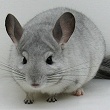Chinchillas.com Newsletter
Volume 5,
Number 1 - Febuary
22, 2007
Auction
Update
A Seminar on Chinchilla Judging Lights by
Dick Bradford
Auction Update
 This week on the Auction, we are offering #7030 (http://www.chinchillas.com/listings/details/index.cfm?itemnum=856675914),
a show quality white mosaic (sapphire carrier) male. This is an excellent
opportunity for a breeder to add desirable sapphire bloodlines
to his/her herd.
This week on the Auction, we are offering #7030 (http://www.chinchillas.com/listings/details/index.cfm?itemnum=856675914),
a show quality white mosaic (sapphire carrier) male. This is an excellent
opportunity for a breeder to add desirable sapphire bloodlines
to his/her herd.
Once again, in 2007,
only a very small group of Angora chinchillas will be offered for
sale. This year we will be offering two different color mutations
that have not been available before. Please look for these exceptionally
rare and beautiful chinchillas in the coming weeks on the auction.
The article below pertains to show & grading lights. We hope it is a help to our clients as they assess the color and quality of their chinchillas at home. This article was written and complied by Mr. Dick Bradford, a very accomplished chinchilla judge and breeder.
A Seminar on Chinchilla Judging LightsReprinted courtesy of Dick Bradford
We did some comparison of chinchilla judging lights.
We took four, 4-bulb fixtures, and installed different fluorescent
lamps in each fixture.
In fixture #1 there were Durotest Daylight 65 lamps installed.
In fixture #2 there were Service F40DX lamps installed.
In fixture #3 there were GE SP65 lamps installed.
In fixture #4 there were GE Daylight F40 lamps installed.
Durotest Daylight 65’s have a CRI of 92.
Service F40DX’s have a CRI of 84.
GE SP65’s have a CRI of 74.
GE F40 Daylights have a CRI of 75.
CRI*
We found after considerable comparison, discussions and reaching a
consensus:
Standing back and viewing the overall view of all 4 fixtures the GE
SP65s definitely appear to have a brighter illumination that is very
“reddish or pinkish” in appearance. The other 3 fixtures
illumination appeared to be about the same in intensity and of the
same light blue hue. When one passed his bare arm under the four different
fixtures 3 of them illuminated the arm equally and you could see the
pinks, blues and whites in your arm as one would in “north light”
daylight. Under the GE SP65 the arm became very, very reddish pink,
nearly obscuring the “blues” in the veins of the arm.
When chinchillas were viewed under the lights of the other 3 fixtures,
one could detect the natural colors of the chinchilla’s fur and
could detect degrees of clarity very well! Under the GE SP65 lamps
the pinkish, reddish hues seemed to cause the “brighter”,
“bluer” animals colors to be distorted and less easy to
detect from the “off color” and “red-tipped” animals.
The intent of the judging of chinchilla fur is to enable the detection
of fine degrees of clarity, blueness and fur qualities. If the blue,
clarity characteristics are “masked” by a red/pink light,
then the only remaining characteristics the animals are judged by
are: size, fur strength, darkness, etc.
*The CRI mentioned above refers to Color Rendering Index, the higher
the number, the better for being able to detect “fine degrees
of color variations”, as compared when viewed in a “true
North Light”. A minimum CRI of 80 they say is best for “grading
work”.
The persons participating in this “mini-seminar” graded
the lights in their opinions as follows:
The Durotest Daylight 65, CRI 92, was the most “critical”.
The Service F40DX, CRI 84, and the GE Daylight F40, CRI 75, were fairly
close to each other, but the F40DX, was “picked” by all
to be a little better than the F40, but both “usable”!
The GE SP65, CRI 74, was seen to be very poor and actually considered
a light that should be “banned” from use as a chinchilla
judging light!
The late Ron Rowen gave several seminars on the Durotest Daylight
65, and its good light spectrum features. It is suspicioned that someone
“confused” the GE SP65 as being the same light spectrum
quality bulb, and it is definitely NOT!!
Now the bad news!
Durotest Daylight 65 lamps cost about $16 each.
Service F40DX, or equivalents, are about $3-$5 each.
GE Daylight F40 lamps, not available any longer.
GE SP65 lamps, around $5-$6, “cheap” but of no value as
a grading light, we believe!
Several other manufacturers (Phillips, etc.) make an F40DX lamp, but
these have not been “tested/viewed” by these individuals.
During
this little “seminar” we also viewed 5 different rolls of
paper for the judging tables and witnessed the importance of using
a very white, white quality paper! The best being as bright as some
of the whitest computer paper, in Brightness ratings of 84-92! Even
the slightly off-color paper tends to cause the “casty belly”
to appear acceptable. We feel the “soft towel-like” paper
absorbs the light and does not allow the judging of the “bellies”
as well as the smooth finished paper!
This is not to indicate we have found the answers, only that in our
opinions:
we should no longer use the GE SP65s,
The Lamps used should have a CRI of 84, or more!
The paper used should be smooth finished, and as bright as 84, or
more!
Notice:
Your personal preferences are set to receive newsletters
and surveys from chinchillas.com. To modify your personal preferences
and unsubscribe, go to http://www.chinchillas.com/personal
and log in to your personal account, select View/edit your personal information
then change "participate in survey" to no and "on mailing
list" to no.
Copyright© 2007 Chinchillas.com All rights reserved. Designated trademarks and brands are the property of their respective owners.
